#contemporary zambia art
Explore tagged Tumblr posts
Text

Striking Roots
Joe Turpin
Lusaka Contemporary Art Centre
August 23 – August 30 2024
“That they could “contribute to the development of liberation movements” and “…earn a civic and national status other than that of colonizer, eternal outsider.” The “foreign” plants might mutate and strike roots.”[1] – Nadine Gordimer
This quote by the late South African writer and Nobel Laureate Nadine Gordimer refers to those white, mainly Jewish, South Africans who joined the anti-apartheid struggle in South Africa. Such a metaphor also applies to Simon Zukas, who was one of the few white people to join Zambia’s liberation campaign and fight against British colonisation and white settler federation. Many of these brave people paid with their extensive time in prison, in exile, and even with their lives, for a cause greater than their own. These political figures and their actions form the point of departure to Joe Turpin’s research and multidisciplinary art practice, informed by the anti-colonial position in Africa, both past and contemporary. Is there a white position in fighting colonialism, and furthermore, is there a an anti-colonial Jewish position as well? How have such figures, who have demonstrated this radical empathy with the colonized masses in our recent histories, been memorialised? These questions pose the thematic concerns that Turpin has grappled with during his residency with Lusaka Contemporary Art Centre.
Striking Roots is the culmination of this work, and is presented as a multi-disciplinary exhibition comprising of paintings, drawings, video, sculpture, performance and installation, which address the aforementioned political and historical wanderings in a visual representation, that ultimately seeks to determine a greater understanding of Turpin’s own identity, and sense of belonging on the African continent.
Joe Turpin (b.1995 in Johannesburg) is a South African visual artist whose research practice focuses on historically charged narratives and semiotics as expansions of painting. Joe makes mixed-media installations grounded in painting that create temporal conversations about identity, memory, and history. His Jewish heritage becomes principal and consequential in exploring stories of migration and persecution. These cultural paradigms inform his archival research and artistic production.
Turpin holds an MFA from the Pratt Institute in New York (2023) and BA in Fine Art from the University of the Witwatersrand in Johannesburg. Joe Turpin was a Top 3 finalist in the 2019 Cassirer Welz Award and a 2022 recipient of the Stutzman Foundation First Year MFA Fine Arts Awards for Three-Dimensional Art. He lives and works in Johannesburg, South Africa.
[1]Nadine Gordimer from Albert Memmi, The Colonizer and the Colonized (London: Profile Books, 2003), 37-38.




#art#joe turpin#painting#artist#installation#turpin#contemporary art#lusaka#zambia#contemporary#exhibition
0 notes
Photo

House render 2br #Architect #Design #Zambia #Architecture #archdaily #arch_more #arch_land #archilovers #architectural #House #interiordesign #3drendering #homedesign #homesweethome #architecturedesign #instalike #instagood #building #urbanism #Modern #archviz #floorplan #render #Archicad #Lumion #Photoshop #Art #architizer #Contemporary (at Lusaka, Zambia) https://www.instagram.com/p/Cp4b1UhIm5C/?igshid=NGJjMDIxMWI=
#architect#design#zambia#architecture#archdaily#arch_more#arch_land#archilovers#architectural#house#interiordesign#3drendering#homedesign#homesweethome#architecturedesign#instalike#instagood#building#urbanism#modern#archviz#floorplan#render#archicad#lumion#photoshop#art#architizer#contemporary
2 notes
·
View notes
Text
"Discover the Beauty of February Birthstone Jewelry - Shop Now"
Amethyst jewelry, a February birthstone, has a fascinating history and unique properties. Named after the Greek word "amethystos," it symbolizes royalty, spirituality, and clarity of thought. Its striking purple color makes it a popular choice for various occasions. When choosing amethyst jewelry, consider factors like color intensity, clarity, cut, and carat weight.
Amethyst is associated with the crown chakra, symbolizing higher consciousness. It is known for its healing properties, promoting calmness, reducing stress, and enhancing spiritual well-being. Amethyst jewelry is suitable for various occasions and can be paired with other gemstones or metals for unique gift combinations.
Amethyst: A Gemstone with History
Amethyst, a purple gemstone, has a rich history and cultural significance also known for February birthstone Jewelry. Originating from quartz, it has been associated with royalty, spirituality, and healing. Its vibrant hues make it a popular choice for jewelry and art. To maintain its beauty, amethyst should be protected from direct sunlight and stored away from other jewelry.
1. Origins and Formation:
Amethyst belongs to the quartz family and is a variety of silicon dioxide. Its distinct purple color is a result of irradiation, iron impurities, and the presence of trace elements during its formation. The gem can be found in various locations around the world, with notable deposits in Brazil, Zambia, Uruguay, Russia, and South Korea.
2. Ancient Beliefs and Mythology:
The name "amethyst" is derived from the Greek words "amethystos," meaning "not intoxicated." Ancient Greeks believed that wearing or drinking from amethyst vessels could prevent intoxication, and it became associated with the god of wine, Dionysus.
According to legend, a young maiden named Amethystos was turned into a quartz crystal by the goddess Artemis to protect her from Dionysus's advances.
3. Royal Significance:
Throughout history, amethyst has been associated with royalty and nobility. Purple was considered a regal color, and amethyst adorned the crowns, jewelry, and garments of kings and queens. The British Crown Jewels feature several prominent amethysts, showcasing their enduring appeal among monarchs.
4. Spiritual and Healing Properties:
Amethyst is often linked to spiritual and healing properties. Many believe it enhances spiritual awareness, promotes a calm mind, and aids in meditation. The gem is also associated with balancing energy, reducing stress, and fostering emotional stability.
5. Art and Culture:
Amethyst has been a favorite among jewelers and artisans throughout history. Its vibrant purple hues make it a sought-after gemstone for creating exquisite jewelry pieces. The gem has been featured in rings, necklaces, earrings, and tiaras, contributing to its timeless popularity in the world of fashion and art.
6. Contemporary Significance:
In modern times, amethyst continues to be a popular gemstone in the jewelry market. Its affordability, coupled with its striking color, makes it a favored choice for both traditional and contemporary designs. Amethyst is often used in engagement rings, pendants, and statement pieces, appealing to a wide range of consumers.
7. Caring for Amethyst:
To maintain the beauty of amethyst, it is essential to protect it from prolonged exposure to direct sunlight, as this can fade its color. Cleaning should be done with mild soap and warm water, and the gem should be stored away from other jewelry to prevent scratching.
1 note
·
View note
Text
Why Amethyst Stone Slabs are the Latest Trend in Interior Design
Amethyst is a type of quartz crystal that is prized for its vibrant purple color. The stone is formed when silicon dioxide combines with iron and other trace minerals in the earth's crust. Amethyst is found in many parts of the world, including Brazil, Uruguay, and Zambia. Amethyst stone slabs are large pieces of amethyst that have been cut and polished to create a smooth, flat surface. These slabs can range in size from small accent pieces to large, statement-making centrepieces. They are often used as tabletops, countertops, and backsplashes in kitchens and bathrooms, as well as decorative accents in living rooms, bedrooms, and offices. Subh Gem Stones, a leading provider of high-quality gemstones and crystals.

Benefits of these Slabs
Aside from their striking beauty, these slabs offer a range of benefits that make them a popular choice for interior designers and homeowners alike.
Healing Properties: Amethyst is believed to have healing properties that can help with everything from physical ailments to emotional stress. It is said to promote relaxation, reduce anxiety, and enhance spiritual awareness.
Durability: Amethyst is a hard, durable stone that is resistant to scratches and chips. It can withstand heavy use and is easy to maintain, making it a practical choice for high-traffic areas.
Unique Look: No two pieces of amethyst are exactly alike, which means that each amethyst stone slab is one-of-a-kind. The stone's natural variations in color and pattern give it a unique look that can't be replicated.
How to Incorporate these Slabs into Your Design
There are countless ways to incorporate these slabs into your interior design. Here are just a few ideas to get you started:
Kitchen Countertops: These slabs make a stunning statement as kitchen countertops. Their rich, purple hue adds a pop of color to any kitchen, while their durability makes them ideal for withstanding spills, scratches, and heat.
Bathroom Vanities: A smaller amethyst stone slab can be used as a bathroom vanity top to add a touch of elegance to your space. Pair it with a white porcelain sink and modern fixtures for a contemporary look.
Wall Art: A large amethyst stone slab can be hung on the wall as a piece of art. The stone's natural variations in color and pattern make it a visually interesting focal point.
Coffee Table: A small amethyst stone slab can be used as a coffee table top. Pair it with a gold or brass base for a chic, glamorous look.
Bookends: Two small slabs can be used as bookends to add a touch of color and texture to your bookshelf.
Why Choose Subh Gem Stones?
When it comes to these slabs, Subh Gem Stones is the go-to source for quality, selection, and value. Their products are carefully sourced from around the world and are of the highest quality, ensuring that you get the best possible value for your investment.
In addition to their exceptional products, we also offer outstanding customer service and support. Their knowledgeable and friendly staff are always available to answer your questions and help you find the perfect product to meet your needs.
We are also committed to sustainability and ethical sourcing practices, ensuring that their products are not only beautiful and beneficial but also responsible and environmentally friendly.
Looking for a touch of luxury and sophistication for your home or office? Look no further than these slabs from Subh Gem Stones, a leading provider of high-quality gemstones and crystals. Contact us today to browse our collection and find the perfect piece for your space. Whether you're a homeowner or a professional designer, our knowledgeable team is here to help you every step of the way. Don't wait - transform your space today with Subh Gem Stones' amethyst slabs.
0 notes
Text

Contemporary Zambian art by Chilyapa Lwando 🇿🇲
#art#contemporary art#contemporary african art#contemporary zambia art#africanartists#zambianartists#black artists
0 notes
Text

Anthony Fineran (B 1981), Zambia Groningen Patta, 2022
#Anthony Fineran#Art#Contemporary#Digital#Internet#Net#Web#Google#Images#Low Res#Favorite#Zambia#Groningen#Patta
0 notes
Photo

John Latham 1921–2006
Man Caught Up with a Yellow Object
1954
Oil on board
H 122.1 x W 97.7 cm
Tate, London
© courtesy The John Latham Foundation. Photo credit: Tate
John Latham: British artist and theorist, born in Livingstone, Northern Rhodesia (now Maramba, Zambia). After serving in the Royal Navy in the Second World War, he studied at Chelsea School of Art, 1946–50. Latham was best known for work in which he used books as raw material. In 1958 he began making ‘skoob’ (‘books’ spelt backwards) reliefs, and in the 1960s he was involved in *Happenings that he called Skoob Tower Ceremonies, in which sculptures made of piles of books were ritually burned—‘to put the proposition into mind that perhaps the cultural base has been burned out’. His most famous gesture came in 1966, when—as a part-time lecturer at *St Martin's School of Art—he borrowed a copy of Clement *Greenberg's Art and Culture from the library and with the sculptor Barry *Flanagan, alongside invited guests, chewed up pages and immersed them in acid to produce a ‘culture’.
Some months later he was requested to return the book by the librarian. He was told it was urgently needed by a student. Shortly after attempting to return the remnants, his contract was terminated. The work created by the chewed pages—entitled Art and Culture—was bought by the Museum of Modern Art, New York, in 1970. In 1966 Latham took part in the Destruction in Art Symposium alongside *Metzger at the *Institute of Contemporary Arts, London. Out of this he founded the Artist Placement Group (later called O + I) with his wife, Barbara Steveni. The intention was to make links between artists and industry. An exhibition at the Hayward Gallery, London, in 1971 publicized his ideas more widely. Although the *Arts Council withdrew funding in 1972 on the grounds that the APG was more concerned with social engineering than with art, the organization continued to make links with business and government organizations. Latham's ultimate concern was not just to find work for artists but to use their input to achieve social change according to a complex theory of the ‘event structure’. His ideas were widely mocked within the art world during the 1970s, partly because, in a climate strongly affected by Marxism, the whole idea of collaboration with business seemed hopelessly conformist. His conception of ‘time-based events’ was greeted by one correspondent to *Art Monthly with the riposte that all events have to be time-based because ‘they get awfully short otherwise’. However, shorn of a philosophy which perhaps only Latham and a few associates entirely understood, the basic practical notion has survived in a changed social and political climate. http://www.tate.org.uk/learning/artistsinfocus/apg/ Resource on the Artist Placement Group on the Tate website.
Source: A Dictionary of Modern and Contemporary Art (Oxford University Press) Second Edition, 2009.
4 notes
·
View notes
Photo

Stary Mwaba’s MFA Exhibition Topping Off Good Years of Dedication, Research and Exchange!
0 notes
Photo

This coming Sat, 26 Sep 2020 from 2pm (BST) The Africa Centre (@theafricacentre) is hosting The International Afro Dance Festival #afrodancefest2020. It’s an online event celebrating contemporary Africa through dance & youth culture. Africa & the global diaspora is bustling with creative talent. We will be showcasing some of the very best AfroBeats dancers from different parts of the world. #Nigeria, #Ghana, #DRCongo, & #Zambia are some of the countries represented. This is about more than just dance, even though dance is an important and effective medium for social upliftment. With everything that is happening in the world right now, from the global health crisis to the uprising against police brutality and institutional racism in different parts of the world, we are creating a celebratory moment to come together to share joy & enjoy captivating rhythmic motions inspired by sounds from the Motherland! . #dance #africa #creative #africandance #african #youth #afrobeats #culture #motherland #africamusic #afrodance #africanstreetart #art #urban #diaspora #globalafrica #music #celebration #vibes #africanmusic #chopdaily #afrogram — view on Instagram https://ift.tt/33MtUyz
6 notes
·
View notes
Text
what i read in july
THAT’S MORE LIKE IT aka i’m finally out of the (relative) reading slump for good & my bro james joyce was there
men explain things to me, rebecca solnit the original mansplaining essay is great, and still scarily relevant; the others in this collection (most on feminist issues) are also quite good; some aspects are a bit dated & problematic so be aware of that. 2.5/5
erschlagt die armen!, shumona sinha (tr. from french, not available in english) short but very impactful novella about a young french woman, originally from india, who works as an interpreter in the asylum system and becomes more & more broken by this system of inhumane bureaucracy and suffering, until she snaps and hits a migrant over the head with a wine bottle. full of alienation and misery and beautiful but disturbing language - the title translates to ‘beat the poor to death’ so like. yeah. 3.5/5
fire & blood: a history of the targaryen family I, george r r martin look, it’s a 700-page-long fake history book about a fictional ruling dynasty in a fictional world, and i’m just That Obsessed & Desperate about asoiaf (and i don’t even care about the targs That Much). anyway, now i know more about the targs than any ruling family from, you know, real history, which is like, whatever. this is pretty enjoyable if you are That Obsessed, although i will say that some bits are much better than others (there are some dry dull years even in everyone’s fav overly dramatic dragon-riding incest-loving family) and the misogyny really is. a lot. too much. way too much. BUT i did really like Good Best Queen Alysanne (her husband king joe harris is alright too i guess) and i found my new westerosi otp, cregan stark/aly blackwood, who both have Big Dick Energy off the fucking charts. 3.5/5 (+0.5 points for cregan and aly’s combined BDE)
the old drift, namwali serpell hugely ambitious sprawling postcolonial nation-building novel about zambia, told thru three generations of three families, as well as a chorus of mosquitoes (consistently the best & smartest parts). there is A LOT going on, in terms of characters, of plot points, of references to history (the zambian space programme) and literature (finally my knowledge of heart of darkness paid off) and thematically, and honestly it was a bit too much, a bit too tangled & fragmented & drifty, and in the end i probably admire this book more than i liked it, but serpell’s writing is incredibly smart and funny and full of electrical sparks 3.5/5
a severed head, iris murdoch the original love dodecahedron (not that i counted). iris murdoch is fucking WILD and i love her for it. this is a strange darkly funny little farce about some rich well-educated londoners and their bizarre & rather convoluted love lives. not as grandiosely wild as the sea the sea, but fun nevertheless. 3/5
midnight in chernobyl, adam higginbotham jumping on the hype bandwagon caused by the hbo series (very weird to call the current fascination with chernobyl a hype bandwagon but you know). interesting & well-written & accessible (tho the science is still totally beyond me) & gets you to care about the people involved. lots of human failure, lots of human greatness, set against the background of the almost eldritch threat of radioactivity (look up the elephant foot & see if you don’t get chills), and acute radiation syndrome which is THE MOST TERRIFYING THING ON EARTH . 3.5/5
normal people, sally rooney honestly this is incredibly engrossing & absorbing once you get used to how rooney completely ignores ‘show don’t tell’ (it works!), i pretty much read the whole thing in one slow workday (boss makes a dollar, i make a dime so i read books on my phone on company time, also i genuinely had nothing to do). i also think rooney is really good at precisely capturing the ~millenial experience in a way that feels very true, especially the transition from school to uni. BUT i really disliked the ending, the book never engages with the political themes it introduces (esp. class and gender) as deeply as it could and the bdsm stuff never really gets TIED UP LOL. so overall idk: 3.5/5
störfall: nachrichten eines tages, christa wolf quiet reflective undramatic little book narrated by a woman waiting to hear about the outcome of her brother’s brain surgery on the day of the catastrophe at chernobyl - throughout the day she puts down her thoughts about her brother and the events unfolding at chernobyl, as well as the double uncertainty she is trying to cope with. really interesting to read such an immediate reaction to chernobyl (the book came out less than a year after chernobyl). 2.5/5
the man in the high castle, philip k dick it was fine? quick & entertaining alternative history where the axis powers win the war, some interesting bits of worldbuilding (like the draining of the mediterranean which was apparently a real idea in the early 20th century?) but overall it’s just felt a bit disjointed & unsatisfying to me. 2.5/5
fugitive pieces, anne michaels very poetic & thoughtful novel about the holocaust, grief, remembrance & the difference between history and memory, intergenerational trauma, love, geology and the weather. i’m not sure how much this comes together as a novel, but it is absolutely beautifully written (the author is a poet as well) and very affective. 3.5/5
american innovations, rivka galchen short collection of bizarre & often funny short stories about neurotic women whose furniture flies away, or who grow an extra breast, or who are maybe too occupied with financial details. very vague & very precise at once, which seems to be the thing with these sort of collections. 3/5
fool’s assassin (fitz & the fool #1), robin hobb YAASS i’m back in the realm of the elderlings!!! i thought this was one of the weaker installments in the series - i still enjoyed it a lot, and Feelings were had, but it just doesn’t quite fit together pacing-wise & some of the characterisation struck me as off (can i get some nuance for shun & lant please?) and tbh fitz is at peak Selfcentred Dumbass Levels & it drove me up the fucking wall. molly, nettle & bee deserve better. still, completely HYPE for the rest of the trilogy. 3.5/5
JAMES JOYCE JULY
note: i decided not to read dubliners bc it’s my least fav of joyce’s major works & too bleak & repetitive for my mood right now AND while i planned not to reread finnegans wake bc……. it’s finnegans wake…. i kinda do want to read it now (but i also. really don’t.) so idk yet.
a portrait of the artist as a young man, james joyce y’all. i read this book at least once a year between the ages of 15 and 19, it’s beyond formative, it is burnt into my brain, and reading it now several years later it is still everything, soaring and searing (that searing clarity of truth, thanks burgess) and poetic and dirty, and stephen is baby, and a pretentious self-important little prick and i love him & i am him (or was him as only a pretentious self-important teenage girl reading joyce can be him - because this truly is a book that should be read in your late teens when you feel everything as intensely and world-endingly and severely as my boy stephen does and every new experience feels like the world changing). anyway i love this book & i love stephen dedalus, bird-like, hawk-like, knife-blade, aloof, alienated, severe and stern, a poet-priest-prophet if he could ever get over himself, baby baby baby. 5/5
exiles, james joyce well. there’s a reason joyce is known as a novelist. this is….. a failed experiment, maybe. a fairly boring play about an adulterous love-square and uh… love beyond morality and possession maybe??? about how much it would suck for joyce to return to ireland??? and tbh it’s not terribly interesting. 2/5
travesties, tom stoppard a wild funny irreverent & smart antic comedy inspired by the fact that during ww1, james joyce, lenin, and dadaist tristan tzara were all in neutral zurich, more or less simultaneously; they probably never met, but in this play they do, as dadaist poetry, socialist art critique, and a james joyce high on his own genius & in desperate need of some cash while writing ulysses, AND the importance of being earnest (joyce is putting on a production of it) all collide in the memories of henry carr, who played algernon & later sued joyce over money (tru facts). not my fav stoppard (that’s arcadia) but it’s funny & fizzy & smart & combines many many things that i love. 4/5
ulysses, james joyce look i’m not really going to tell y’all anything new about ulysses, but it really has everything, it’s warm & human(e) & cerebral & difficult & funny & sad & healing & i always get a lot out of it even tho there’s bits (a lot of them) i’ll never wrap my head around. ultimate affirmation of humanity or whatever. also stephen dedalus is baby. 5/5
dedalus, chris mccabe the fact that this book (sequel to ulysses about what stephen dedalus might have done the next day) exists and was published ON MY BIRTHDAY is proof that the universe loves me.
anyway this is very very good, very very clever, extremely good at stephen (less good at bloom but his parts are still good), engages w/ ulysses, portrait & hamlet (& others) very cleverly & does some cool meta and experimental shit. y’all it has stephen talking to a contemporary therapist about how he’s stuck in joyce’s text which is all about joyce & very little about whoever stephen is when he’s not joyce’s alter ego/affectionate but slightly amused look at younger self and ithaca is an interview w/ the author about how his relationship to his dad influenced his response to ulysses and I’M INTO IT. the oxen of the sun chapter replaces the whole ‘gestation of english prose’ w/ just slightly rewriting the first pages of about 10 novels published between ulysses and now & it does lolita w/ “bloom, thorn of stephen’s sleep, light in his eyes. his sire, his son’ and i lit. screamed. anyway i don’t want to give this 5 stars (yet) bc i think some of the experimental stuff ended up a bit gimmicky & didn’t add that much to the text but fuck. that’s my boy & i want to reread it right now. 4.5/5 ALSO it’s a crime no literary weirdo woman has written ‘a portrait of the artist’s sister’ about delia ‘dilly’ dedalus, shadow of stephen’s mind, quick far & daring, teaching herself french from a 3rd hand primer while her father drinks the nonexistent family fortune away and her older brother is getting drunk on a beach & starting fights w/ soldiers bc he’s a smartarse
1 note
·
View note
Link
The Finland Experience – Sights, Sounds, and People
Wouldn’t we all like to know what makes the ‘Happiest Country in The World’ tick? Well, a visit to this snow-filled (yet warmly inviting) wonderland and its treasure-trove of art, music and architectural wonders would probably answer that question for you.
One might argue that the best time to visit Finland is in the winter . However, this is not always true: Finland is a year-round adventure; Helsinki at springtime and Lapland in the winter are two vastly distinct experiences, yet both are scintillating in their own right. Nature – and You. Finland has natural beauty that you may not be able to find anywhere else. It is one of the few places in Europe that true wilderness exists. Finnish nature is revered for its wild charm. High, stone-clad slopes in Koli tower over clear, cool waters – one of Finland’s most visited sites. Understandably so, as landscapes in this country bring you closer to nature and pull you back to a time where one might even believe they belonged in a Medieval fairytale. The Devil Rocks of Läpisyöksy are made up of jagged naturally-carved inner crevices that scream when rough Northern winds blow through them. And if these peculiar – yet fascinating – sights weren’t enough, rock labyrinths exist a mere hour away from Helsinki for you to lose yourself in completely. Finnish nature is rough and unrelenting at first glance, still its beauty has depth upon exploration.
Sustainable Travel Many Scandinavian countries are starting to incorporate sustainability into their tourism, and Finland is no different. The country and its people take pride in the natural beauty that exists and thrive in oneness with it. Incorporating this mindset into their daily life has seen Finland transform their architecture into one whose design is sustainable, yet sleek and minimalist. ‘Slow Food’ and ‘Slow Travel’ are two more babies born from this initiative: whole, organic, green and ethical farming (and eating!) as well as exploring the country through bicycles, trains and on foot are what this concept is about. The idea is to take your time in this beautiful country, and explore both visually and gastronomically with mindfulness. Together, the experience is a must-feel – the connection that is felt with nature is a purposeful one, and once you feel it you just won’t be able to get enough! Explore Finland – Helsinki, Lakeland, Lapland and The Archipelago Helsinki This is the capital of the country, and also its largest city – both in terms of population, and sustainability. With one of the best public transport systems in the world, it is easy to find yourself and your way in the same trip: its laid-back atmosphere allows for people to explore its sights without feeling judged, or congested.
There are myriad things to do here, one of the most popular being their public saunas: both locals and foreigners flock to these steamy baths to relax and unwind. Travelling by one of the easily available and uber-connected flights (or by ship through the Baltic Sea – which is breathtaking, by the way) takes a toll on our bodies, and what better way to calm the nerves than by laying in a soothing sauna? The opera and ballet scene in Finland thrives, so why not take this chance to immerse your senses in a Renaissance-like atmosphere as well?
There are 6 national parks less than 2 hours away from the city, which means flora and fauna are just waiting for you to arrive! Other neighboring attractions include the historically rich city of Porvoo, the Järvenpää-Tuusula area that’s known for its artistic heritage, and the ironwork villages speckled in and around Helsinki. The region is a melting pot of culture, history and metropolitan flair that’s bound to keep you entertained!
Lapland Lapland is the northernmost area of Finland, and the place to go if you want to experience the true Nordic nature of the Finnish mountain folk. A region of contrasts, where the summer sees 24-hour sunlight and the winter sees dark, Aurora-filled nights. Speaking of Aurora, this is the destination many flock to, to take a peek at the Northern Lights, one of the most magnificent natural phenomena the world has given us.
But that’s not all Lapland has to offer. Other attractions include amazing outdoor ski resorts and special arctic-themed hotels (i.e., winter wonderlands that you can explore from the inside-out: glass igloos, snow castles, and aurora domes that guarantee an authentic and relaxing stay). Lapland also has majestic, towering frozen waterfalls (straight out of Frozen, we reckon) and peaceful reindeer farms that are open to visitors – authentic one-of-a-kind memories that are just waiting to be made!
Lakeland Welcome to an area filled with sparkling blue lakes and rolling green hills, both at the same place. Must-do water activities include steamboating and SUP boards – but if you’ve come to relax, the serene lakeside view is perfect for a calming sit-down as well. Winter paves the road for new adventures, too – waters on the lakes freeze into ice that’s perfect for snowmobiles, ice fishing, fat biking, and cross-country skiing.
Lakeland is more than just looks – its overwhelming visuals make way for the cleanest water in the world, which means you’re not just looking at nature – you’re feeling it, too.
The Archipelago What does the Finnish coast have to offer that other coasts don’t? Well, the answer lies in their rustic towns, Nordic fishing, and lifestyle.
Nötö is a quaint village area in the southern Finnish archipelago that people go to unwind and slow down in life – the Bed-and-Breakfasts are perfect for wholesome breakfasts that stretch out into lunches, and the atmosphere guarantees a dip in stress levels. We’re not sure if you’d ever want to leave, though!
Another inspiring part of Finland is Åland, located in the Gulf of Bothnia. The archipelago of Finland is arguably the one that receives the most sunlight, and with it, a heartwarming sunset as well. Åland is the perfect place for this – enjoy a romantic boat ride and Medieval bike trips around this archipelago that feels like you’re sailing back in time. Finnish Culture Each part of Finland hosts their own definitive style and way of life. What brings all the different parts together is the warmth and genuineness that Finnish people have in common. Although people here are known to be introverted and reserved, once you get to know them you’ll find yourself making friends that will last a lifetime. They enjoy their own space, however, they love to bond and make meaningful connections with people whom they feel comfortable with – you’ve just gotta give yourself time, and before you know it, you’ve made a new friend!
Finnish culture goes beyond their people, though – one of the countries’ archipelagos, Åland, is so unique that they own their own distinct taxation system and postal stamp, too!
What else is Finland known for? One of the World’s most famous architects is from Finland, too – Alvar Aalto. Finland boasts a booming classical music scene as well, with some of the best conductors hailing from here, and the world-famous composer Jean Sibelius adding to the list. Their wood-inspired architecture and international classical and hipster music festivals keep creating new benchmarks for contemporary art, design, and music around the globe. Some of their most notable accomplishments include the newer constructions of Oodi Library and the sauna Löyly, as well as festivals like Helsinki’s Flow (an indie favourite), the Kuopio International Dance Festival and the Savonlinna Opera Festival.
Furthermore, it’d be stating the obvious if we said Finland is known for its saunas – but it is! Like we stated before, Finnish saunas are enjoyed by both locals and foreigners alike. And for good reason, too: these people take their saunas very seriously. Those who are able to, go at least once a week, usually on a Saturday. It seems to be an interesting yet vital part of the country’s culture. This being said, saunas here are a wonder to behold – stepping into a hot, steamy room from the country’s frigid climate is both relaxing, and comforting. Being enveloped in the warmth of the room, and coming out to the warmth of the people is what Finland has in store for us all.
The Food Scene We’ve said this before and we’ll say it again – Finnish folk have a bond with nature that transcends boundaries. It makes its way into the nooks of local mushrooms after September monsoon, and the crannies of chef’s hats in their Michelin restaurants. With one of the most innovative food scenes in Europe, they blend local ingredients into an awakening gastronomic tour (which they actually offer – food tours are the way to go!). Iconic Finnish foods include Karjalanpiirakka (a mouthwatering savoury pastry filled with potatoes, rice or carrots) and Mustikkapiirakka (Finnish pie-like dessert made from wild native bilberries and lingonberries). We recommend that you try out as much as you can – once you start there’s really no end!
Apply Visa OnlineApply For France E Visa Online Apply For China Visa Online Apply For Dubai Visa Online Apply For Australia Visa Online Apply For Azerbaijan Visa Online Apply For Bahrain Visa Online for Indians Apply For Cambodia Visa Online for Indians Apply For Egypt Visa Online for Indians Apply For Malaysia Visa Online for Indians Apply For Zambia Visa Online for Indians
0 notes
Photo

Two Bedroom house render #Architect #Design #Zambia #Architecture #archdaily #arch_more #arch_land #archilovers #architectural #House #interiordesign #3drendering #homedesign #homesweethome #architecturedesign #instalike #instagood #building #urbanism #Modern #archviz #floorplan #render #Archicad #Lumion #Photoshop #Art #architizer #Contemporary (at Lusaka, Zambia) https://www.instagram.com/p/Cpj9pc9IeUT/?igshid=NGJjMDIxMWI=
#architect#design#zambia#architecture#archdaily#arch_more#arch_land#archilovers#architectural#house#interiordesign#3drendering#homedesign#homesweethome#architecturedesign#instalike#instagood#building#urbanism#modern#archviz#floorplan#render#archicad#lumion#photoshop#art#architizer#contemporary
4 notes
·
View notes
Text
#Opportunities - Art Connects Us Research Grants

Call for Expressions of Interest – April 2018
1. Introduction The British Council is aiming to increase connections between the UK creative sectors and young creative professionals in Sub-Saharan Africa. As well as building connections, we aim to expand knowledge of contemporary African art in the UK with a view to more work from Sub-Saharan Africa being seen and experienced by UK audiences. With this in mind we are seeking expressions of interest from UK based arts organisations / curators / programmers working in any of the following art forms - Visual Arts, Literature, Music, Theatre, Dance, Architecture, Design, Fashion and Film to travel to Sub-Saharan Africa and conduct research through the ‘Art Connects Us’ grants. The trips should take place between June and Dec 2018. Research may take the form of meeting with potential artists and partners; finding out more about your chosen art forms�� ecosystem in a particular country or countries; gaining an understanding of art trends in Sub-Saharan Africa; meeting arts organisations and/or attending events and festivals with a view to programming or curating work in the UK. The countries covered under the programme (in which the British Council operates) are: Botswana, Ethiopia, Ghana, Kenya, Malawi, Mauritius, Mozambique, Nigeria, Rwanda, Senegal, Sierra Leone, South Africa, South Sudan, Sudan, Tanzania, Uganda, Zambia and Zimbabwe.
2. Aims of the programme This opportunity aims to: - facilitate the UK creative sector’s ambitions to connect with young, African creatives and art professionals who are 18 to 35-year-olds; - increase opportunities for UK arts organisations and individuals to visit African cities and gain further insight into the chosen local art sector; - encourage and support the development of networks that connect the UK and Sub-Saharan African arts sectors for the long term; - widen the opportunities for art professionals in Sub-Saharan Africa to connect with UK arts organisations and arts professionals.
3. Art Connects Us Our programme aims include these three core elements: Art, audiences and innovation – sharing the best of arts and culture in Sub-Saharan Africa and the UK is at the heart of our agenda. We bring partners together to bring new art to audiences. Skills and networking – we strive to expand audiences for the arts through developing new networks and skills for our partners. Brokering and communication – we communicate the work of the creative sectors where we work, enabling artists and audiences to connect with each other. We aim to support the aims and ambitions of artists. Our work also recognises that supporting the development of cultural industries can enable more people to engage with creativity as artists and audiences and contribute to more prosperous, fulfilling and happy lives for us all. The following strands of work enable us to focus our work in areas we feel have relevance to audiences in the UK, Sub-Saharan Africa and globally: We look to improve the knowledge of the UK creative sector of contemporary African arts and increase the opportunity for UK artists and audiences to engage with young African art practitioners and their work through the partnerships we develop. Our work on festivals focuses on enabling these cultural platforms to be a convening point for artists to meet, forge new networks, share skills and connect their art directly with new audiences. Through our creative enterprise programme we look to enhance the livelihood potential for entrepreneurs, freelancers and other professionals in the creative economy. We do this by offering skills development opportunities often working through creative hubs and their communities. We also facilitate connections between UK and Sub-Saharan Africa hubs and their networks to stimulate learning, exchange and collaboration. Developing digital engagement across the Sub-Saharan Africa region through innovative projects, programmes and partnerships. By supporting artists to make digital content we aim to present a more diverse Africa to a global online audience. We seek new and innovative ways to enable the people of the UK and Sub-Saharan Africa to see each other through art, gaining a rounded picture of our contemporary lives. The programmes are shaped by the artists we work with and our cultural relations agenda. We believe that supporting more art to be made and enabling it to reach new audiences has a positive impact on the lives of people in the countries in which we work. In doing so, we hope our arts programme makes a contribution to the challenges of the day.
4. Sub-Saharan Africa Region Structure: The region is arranged in three clusters: East, West and Southern Africa. Each one of the clusters has its own Arts strategy that takes as a starting point the overarching strategy for the region, and responds to the needs of the local cultural context, its strengths, issues and potentials. Expressions of interest will need to focus their research within a specific cluster. We welcome proposals that will aim to research in more than one country in their chosen cluster. Please find details of each cluster strategy and objectives in the Notes section at the end of this document.
5. The Grant The British Council will award up to 12 research grants of £2,500 (each) to proposals to undertake research in the Sub-Saharan Region between June and Dec 2018. There will be a maximum of 4 proposals selected per Cluster. 5.1 The selected applicants will be expected to: - Commit time before the visit for preparation and research, including a briefing session in advance (either in person or via video conference); - Provide a plan of travel and study before departure for the research visit in the region; - Document observations and keep a travelogue which could be published via the British Council; - Provide a final report outlining main research finding and potential suggestions for future programmes. The report could take different formats (e.g. written, digital, film, photo-essay, interviews, podcast); - Organise, in consultation with the British Council, a public forum in the UK to share the research findings with the creative community. - Be UK based 5.2 Press and publicity - The selected grantees are expected to agree to any reasonable requests for press or media, to discuss media coverage with the British Council and to assist in ensuring the British Council is credited in any press coverage sought independently. - Press information will be agreed upon and released by the British Council.
6. Criteria The successful applicant is likely to: - be based at UK arts organisation or individual with a proven track record of working internationally; - have a minimum of 5 years professional experience in their sector; - demonstrate how the research proposal aligns with (or addresses) at least one of the ‘Three Key Objectives’ of the cluster you have selected; - demonstrate experience in working with international partners to deliver collaborative arts programmes; - have a basic knowledge of their chose art sector in the region which is being visited (although the British Council will provide support in putting together a detailed programme); In addition, applicants should: - commit to programme a UK public forum to share/disseminate the research findings; - be able to travel between June and December 2018.
7. How to apply If you would like to apply for this Art Connects Us grant please submit a PDF Expression of Interest. This should comprise: - Up to 3 examples of key projects and/or programmes (realised or speculative) that you feel represent your work - A short statement (max 800 words) outlining why you are applying for this research grant and clearly state the following: o State the cluster (and the countries in that cluster) you would like to focus and conduct your research o State how your research proposal aligns with or addresses at least one of the ‘Three Key Objectives’ of the selected cluster (see Notes section on page 5). o State what you hope to gain from the experience and outline some of the potential practical applications of the research into a tangible programme or project. - Activity plan; identify the main stages of your activity during the research visit. - CV (up to 2 pages)
Submissions should be in a single PDF file and not to exceed 2MB in size. These should be emailed to [email protected] by 18:00 (GMT) on 11 May 2018
8. Selection Applications will be assessed against the criteria in point 6. and against the project aims in point 2. They will be reviewed by a selection panel, including representatives from the British Council Art team, previous Arts Connects Us grant recipients and the Royal African Society.
Successful applicants will be notified by Monday 28th May 2018. For further information or enquiries please contact Nadine Patel [email protected]
NOTES a. The Sub-Saharan Africa Clusters (overview and key objectives) West Africa (WA): (Nigeria, Ghana, Senegal, Sierra Leone) The West Africa context is one with democratic governments but unstable transition / election cycles, relatively small middle class with high levels of inequality, significant national and international migration, large youth population, a weak skills base and high unemployment, low broadband penetration but growing fast, and rapid mobile phone penetration. The arts and creative industries in Nigeria and Ghana are rapidly growing and increasingly recognised as economic powerhouses and job creators for young people across music, film, fashion, and the performing and visual arts, leading to increasing public and private support for the sector. In Sierra Leone, influenced by Ghana and Nigeria, and due to a lack of cultural infrastructure for performative arts, there is growing interest in video and film and the music industry is also growing. Street art is also a significant part of the arts scene. In Senegal, historical public support for arts means a strong focus on artistic practice in dance, literature, music and film particularly but less developed creative economy but this is changing quickly. In the UK, there is interest in the West Africa creative sector particularly in Nigeria by diaspora and non-diaspora players especially in film, music, fashion and technology sectors.
There is diaspora and non-diaspora interest in Ghana and Sierra Leone to varying degrees but at a much lower rate compared to Nigeria. There is also UK interest in francophone countries like Mali and Senegal particularly in music and dance. In light of this external context and bearing in mind country, corporate and regional arts priorities, our West Africa Arts vision for 2017 – 2020 is outlined as follows:
Three key objectives for West Africa: Objective One - An increase in the number and quality of UK collaborations, exchanges and connections with artists and creative entrepreneurs in West Africa. Objective Two - Stronger networks (informal or formal) and communities of (young) artists in West Africa will have a stronger voice in, and for their communities and can engage in more institutional UK– West Africa partnerships that are mutually beneficial and to scale. Objective Three - More up to date and diverse awareness and representation of West Africa arts in the UK and vice versa.
East Africa (EA): (Kenya, Uganda, Tanzania, Rwanda, Ethiopia, Sudan, South Sudan) We develop stronger creative sectors in East Africa that are better connected to the UK. This enables the UK to hear the voices of young East Africans and supports the provision of new choices for individuals who wish to make a living through creative careers. We work with future leaders of the creative sectors to create lasting impact, knowledge and understanding between East Africa and the UK. East Africa Arts connects contemporaries in the UK and East Africa, engaging them in mutually beneficial programmes which support individual, social and economic development. By 2020, British Council’s East Africa Arts Programme will have created 20,000 (figure to be agreed on with East Africa Arts board) meaningful connections between East African and UK creatives. These new connections will bring mutual knowledge, insight and understanding of Contemporary British and Contemporary East African culture. It is through these new connections that innovative creative content is created; new audiences are reached; and positive engagements between British and East African 18 to 35-year-olds are created.
Three key objectives for East Africa: Objective One - Greater Reciprocal Showcasing between the UK and Eastern Africa. Objective Two - Increased Opportunities for Mutual Sustainability in UK and EA Arts Sectors. We will create a measurable increase in skills and networking opportunities to strengthen art scenes in BOTH the UK and Eastern Africa. Objective Three - More collaborations are created across and between Eastern Africa and the UK. Through this change, we will ensure the UK sector has greater access to collaborative opportunities across Eastern Africa, and vice versa.
Southern Africa (SA): (Botswana, Malawi, Mauritius, Mozambique, South Africa, Zimbabwe, Zambia) The Southern Africa cluster countries range substantially in economic, social and political detail. From the stable, yet conservative Botswana with a fledging arts sector and keen interest from Government, to the challenged and dependent Malawi, and the economic challenges of Mozambique, all are vastly different. Artistically all the countries look as different, some with strong emerging markets and infrastructure (South Africa and Zimbabwe), to an energetic contemporary creative community (Mauritius), or a developmentally focused arts environment (Zambia and Mozambique). Whilst many of the countries are struggling for basic needs, the artistic and creative communities have much to offer, share and tell the stories of contemporary Southern Africa.
Three Key Objectives for Southern Africa: Objective One - Creative Insight: Listening and Brokering By 2020 we will have built relevant and detailed insight in all 8 countries in the Cluster to better connect contemporary Britain and Southern Africa. We will do this through partnerships and brokering for mutual understanding and shared purpose. Objective Two - Creative Opportunities: Art and Skills To strengthen the professionalization of the creative sector (Southern Africa cluster and UK) in artistic, digital and entrepreneurial means by 2020. We will do this through co-creation, collaboration, projects and experiential exchanges between the countries. Objective Three - Creative Communities: Networks and perception change To deepen and build a greater understanding and connection between contemporary UK and cluster countries so they may work more effectively together artistically, socially and economically.
b. Useful links and resources: For more information on our work in the Arts please visit: https://www.britishcouncil.org/arts Previous Art Connects Us grantees: https://www.tegaokiti.com/
For more information about British Council Sub-Saharan Arts please visit: https://www.britishcouncil.org/east-africa-arts/about https://connectza.tumblr.com/ https://www.britishcouncil.org.gh/programmes/arts
#opportunities#arts opportunities#british council#british council arts#art connects us#southernafricaarts#eastafricaarts#westafricaarts#connect za
1 note
·
View note
Text
Why does Black Panther look Like That? Trailer 1(Part One): Wakanda
I’m breaking down the Black Panther trailer(yet again I know), but this time focusing on it’s aesthetics and trying to point out the reasons behind some of the design elements, and the cultures that inspired them, in another super long, super detailed blog post. No, shush I am not obsessed okay just go with it.

Looking through it(for the hundreth time) I realized that Black Panther has pulled from a vast number of cultures and communitites, so I may miss some, or get others wrong. The points below will be largely based on my own cultural experience(and meagre education on Traditional African Society) and some google :3. So this is like 60 percent speculation. Feel free to correct me. I also try to avoid spoilers below, but here’s a potential spoiler alert just in case.
With that out of the way, Enjoy!
Part One: Location; Let’s Talk About Wakanda
You can read about its history here but it’s basically a futuristic African country.
In the trailer we get this great overhead reveal of Wakanda. Note the shapes of the buildings, especially the roofs. Despite looking contemporary at first glance, they follow a similar design to grass thatched huts.

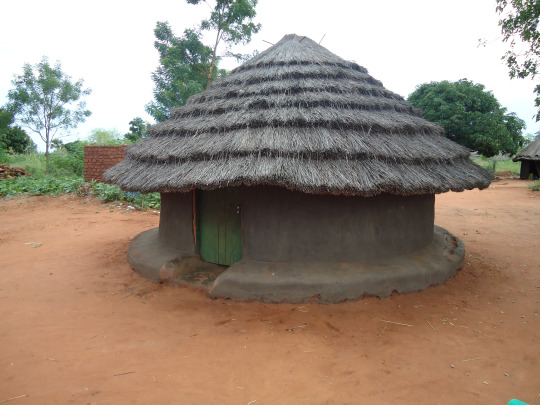
Next we have a shot of the people receiving their King as he returns from a journey.
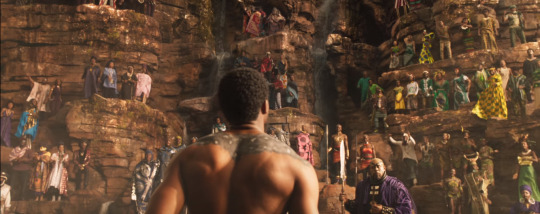
This Wakanda follows some African countries in that they are a people of different comunities or tribes with different ancestry,culture, customs, mannerisms or attire(or even languages) living together. Where I’m from we’re 47 tribes living in a country about the size of Colorado.
There is also the guy in purple in the middle ground of the photo. I’m guessing this is the King’s personal advisor or the royal witch doctor, or both(more on him below).
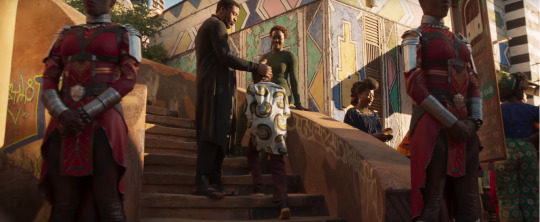
In this shot, it looks like T’challa is taking a stroll in some Wakandan town(I’m assuming because of the grafitti on the walls) with Lupita’s Nakia as the Dora Milaje(the royal guard) stand guard nearby. Note the building behind them is covered in art made up of colorful shapes. That is very similar to the architecture of the Ndebele located in South Africa, Zimbabwe and Botswana.

We also have a shot of the king’s throne room:
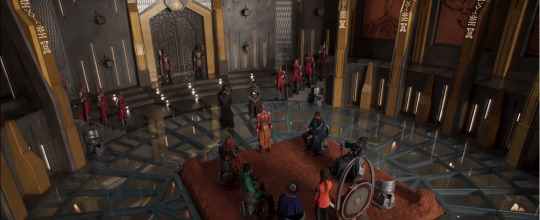
The Dora Milaje stand guard(along with two guards of Mr. Green?). It looks like the elders, or representatives of every tribe, are coming together to have a super important meeting. Maybe a trial? In traditional African society the chief would make the decisions but he would often be surrounded by a counsel of wizened elders who would advise or caution him. In some communities people who broke the rules would be brought to the elders who would decide the right punishment for them. They would also resolve conflicts among the people, and preside over special occasions like naming ceremonies, weddings, funerals among others. In some, there would be no chief, only a council of elders. Some communities still have councils to this day.
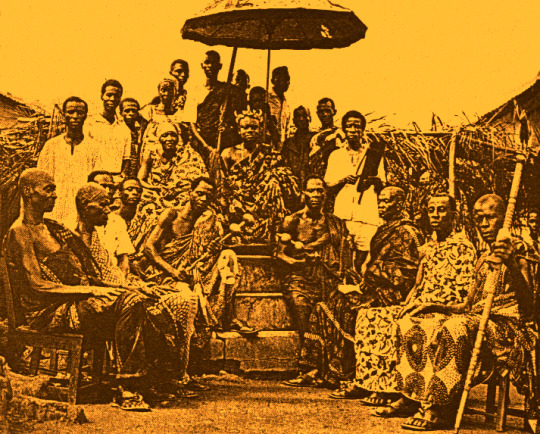
However, it could also be representatives of the different tribes or clans of Wakanda, meeting to discuss an issue that affects or will affect them all. This is not uncommon. Some tribes would be divided into different clans, if something important needed to be discussed, each would send a representative. They had to be well spoken and knowledgable in the rules of the community.
Note the colours chosen for the achitecture of the throne room. Instead of portraying materials like marble, they have stuck to earthy tones and gold(which may have been used to symbolize royalty).
Here we have Nakia, Queen Ramonda and Everett Ross at what looks like a shrine high up in a mountain:

I brightened it up a bit.
At first I thought it was a shrine, but it looks more like the base of operations, or home, of one of our antagonists(more on him under attire). It would also explain why they have fur in their attire, because the live high up on the snowy mountain peak. Some mountains like Kilimanjaro,(that one in the opening scene of the Lion King) are so high that they have snow at their peaks, despite being in tropical(hot all year) places. See the gif below for the Lion King scene...

Just kidding here is the real one. And a photo of the real thing for comparison.
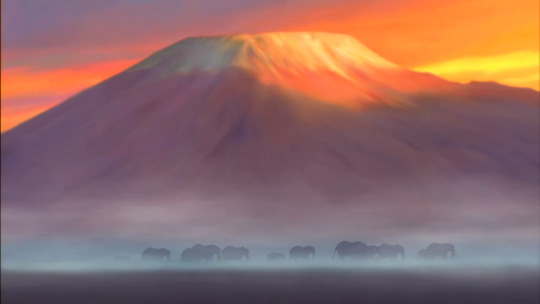

Moving on, in this shot we have some Wakandans performing what looks like a ritualistic task:
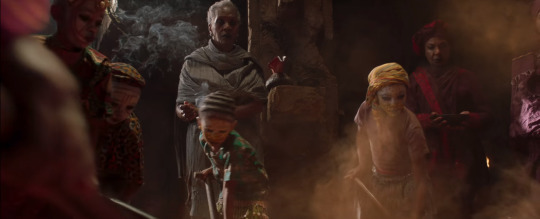
They could be making the herb that gives Black Panther his abilities, in preparation to ‘anoint’ the next Black Panther.
Many communities have had close relationships with nature. People could easily recognize which plants were food, medicine, poison, for toothbrushes or even toilet paper(yup). And in villages there was often a lineage(often that of the witchdoctor) specializing in herbalism. Today, industries have been built around providing herbal remedies. I assume that this herb is considered to be royal or even of divine nature.
I also think that this is happening right before or after the fight between Killmonger and T’Challa. I say this because the children of the community, who have been gathered and their faces painted in a distinct, almost ghostly style, similar to that of the face painting of the Surma of South Sudan and Ethiopia, are given the task of stirring something off screen.
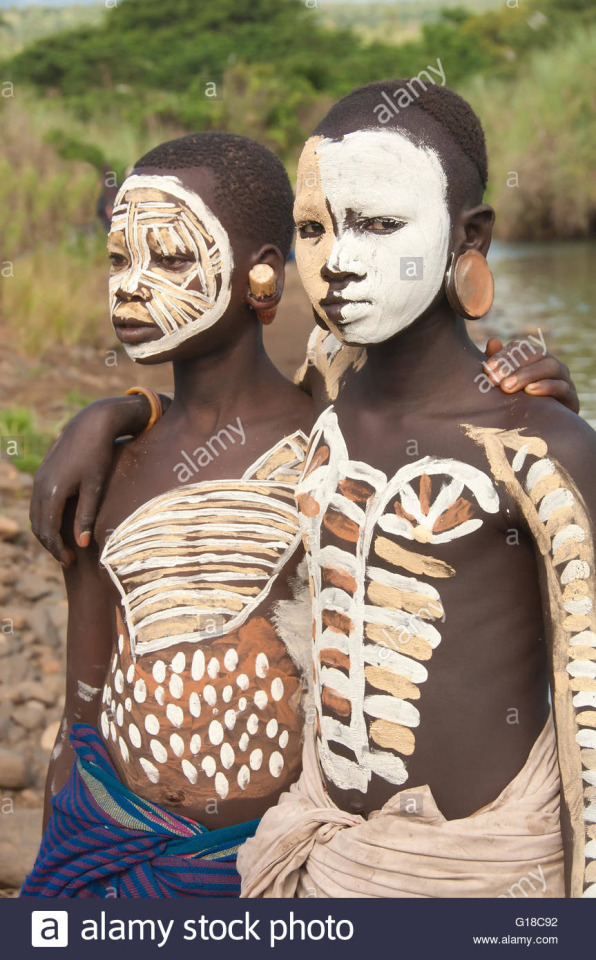
Only the children seem to be stirring away as the adults stand solemnly in the background. To me, it looks like this is an important, even sacred, ceremony for the community of Wakanda. If they were following traditional African culture and this was just casual cooking, it would be the women handling the food, with the children doing errands(and the men out on the farms or something).
Take note that our royal advisor/witchdoctor is present, possibly supervising.
Next we have a waterfall reminiscent of(but isn’t actually) the Victoria Falls in Zambia. If you go to the image here, you see that the Victoria falls look like a literal crack in the ground with water flowing into it, like the pic below.

There was also something similar in The Lion King.

And that’s it for now!
Thank you for making it this far in my long rambling rant. I like inspiring people to discuss so don’t feel shy to disagree or agree. If you love it, hate it, let me know!
I’m still working on Part 2 and 3, (ALAS I SAW THE LAST TRAILER TOO LATE. I’m posting this before I watch it) but I hope to finish the series before the actual movie. Once I have it ready I’ll link it here.
Thanks again! Here’s your potato.

6 notes
·
View notes
Text
BLOGTOBER 10/28/17: THE BELIEVERS
The first time I ever saw THE ROCKY HORROR PICTURE SHOW in a theater, I was 12 years old. My family took my little brother and me on a short vacation to New York City, and indulged my burgeoning obsession by agreeing to take me to the still-thriving cult’s home base at the Waverly Theater. While I had almost nothing on my mind other than this opportunity to commune with the original cultists, and practice with them in their hallowed chapel, I was already ensconced in a real world of faith and ritual that I had much less ability to address. We stayed in the apartment of my parents’ friend Phyllis Galembo, a noted photographer of religious practice and folk conventions in Haiti, Brazil, Cuba, Jamaica, Nigeria, Sierra Leone, Berkina-Faso, Zambia, South Afica, Egungun and Gelede Benin. I had met Phyllis a few times; I remembered her as warm, energetic, and fairly hilarious. I was curious about her work in my childish manner, without having developed a shred of the intellectual wherewithal to think usefully about these other cultures. In spite of what I knew, I was completely startled by her apartment. It was fairly tiny, as per Manhattan standards, and it thrummed with music that I could only identify as “foreign”. Her walls were covered from floor to ceiling with masks, photographs, costume pieces and art objects from her travels. The effect was overpoweringly fascinating. I followed her around the place for a little bit while she prepared to vacate, and then, like a complete asshole, I asked, because it was my only point of reference for my surroundings: “Have you ever seen THE BELIEVERS?” She tersely spat something about it being “racist trash”, putting the topic straight to bed.
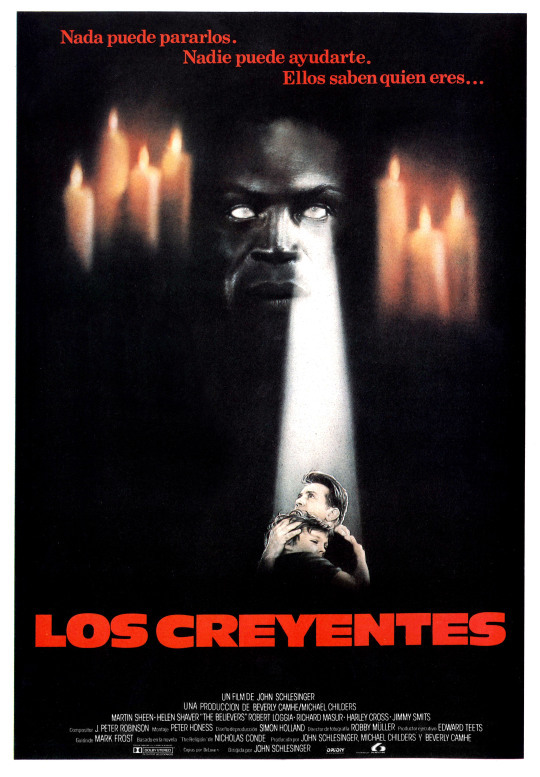
THE BELIEVERS was a movie that I had seen quite a few times on Fox’s weekend horror matinee, my rare and treasured opportunity to watch scary movies, edited for television, with my nose pressed to the screen of our tiny black and white set. This 1987 John Schlesinger thriller concerned a recently widowed police psychiatrist who finds himself embroiled in the grim doings of a deadly Santeria cult. I loved it. Martin Sheen is the traumatized lead, who is trying to juggle a new love with monitoring his young son’s mental health, as a series of apparent human sacrifices arises in New York City. The inimitable, and here, white-eyed Malick Bowens plays a Pied Piper character who makes bloodthirsty acolytes out of rich white socialites who can never have too much money or power. An attenuated dread underlies the film’s seductive, overcast sleepiness, which blankets its intimate images of the New York that is not pictured on postcards. The pensive uncertainty that pervades THE BELIEVERS is punctuated, rarely and unpredictably, with gamey gore, or live bodies erupting with pestilence. While it never achieves the profundity of something like THE EXORCIST, it is not without moments of pathos, like the mourning process of losing one’s mind that a young Jimmy Smitts must undergo. THE BELIEVERS may not be deep, but it is strong.
This is all, of course, without mentioning the issue of race. When the movie came out in 1987, it may still have been possible for many audiences to ignore the movie’s essential xenophobia–that is, more possible than it is now, when discussions of racism make the news with much greater frequency detail, even if the vast majority of us are still struggling to address it properly. Viewers who were primed to condemn negative imagery related to slaves or “savages” were not as often enabled to, for instance, recognize distorted messaging about Afro-Carribean religions that developed under colonial duress. THE BELIEVERS attempts to exonerate itself by taking the popular tack of sorting ethnic characters into “good guys” and “bad guys”. It presents various intelligent, complex, and well-intentioned non-white professionals, often in beautifully photographed Black and Brown neighborhoods where Santeria is commonplace, who wind up serving as a counterpoint to the literally-dark and mysterious interlopers whose activities point to the profoundly evil potential of their shared religion. We still do this today, with this same thematic material, since now we have the option of assigning the locus of evil to Palo Mayombe, a religion whose public image has been permanently and popularly tainted by the real-life murder cult of Adolfo de Jesus Constanzo. Many people seem to get a false sense of progress from the fact that shows like Criminal Minds now pompously explain to viewers that Santeria is a nice “one of the good ones” religion without blood sacrifice, unlike that nasty Palo business. THE BELIEVERS had no such contemporary convenience, and has to settle for glibly parsing Santeria from “brujeria”. If the movie is unclear about the nature of Santeria in general, other than some suggestions that it is normal and typically benign, it is not exactly helpful to add to this hazy mix a blacker-than-black witch doctor who has come to America to chew up little boys like some fairy tale ogre.

Does it help that rich white people are the majority doers of evil in THE BELIEVERS? I think the answer is, not totally, but somewhat. There’s something to the notion that the serial child murderers that Martin Sheen encounters are only happening because the greedy desires of Manhattan’s elite insist upon them. And it isn’t only the posh, grown-up ski school villain types, either; Sheen will soon find among the guilty his own ostensibly liberal pals, whose multi-culti home decor serves as a pushy declaration of the owners’ worldliness. Indeed, in spite of their apparent desperation to be perceived as leaping over cultural boundaries, these dashiki-clad white folks are only truly interested in non-anglo cultures when there exists the promise of supernatural power that may beget even greater material wealth. It’s actually a very good allegory for the diluted, cherry-picked amalgam spirituality that festers in the corners of headshops and new age bookstores, where aimless Americans browse for artifacts that will help them “manifest” more love, sex, or money, or reflect negative energies back upon those who have allegedly cursed them–all without having to spend so much as a minute learning about what an orisha is or where dream catchers come from. It is difficult to get past the cartoonish positioning of Malick Bowens as a sort of antichrist, and the way that this real-life religion is depicted as a tool to drown “civilized” society in its own blood. But, at least the movie more than flirts with the option of accusing our white upperclass of polluting and perverting other cultures for the furtherance of their white upperclass endeavors. At its best, THE BELIEVERS seems to say that if this Afro-Carribean religion serves evil, then it is white Americans who make it so.
I was a little nervous about watching THE BELIEVERS as an adult, but I found that I still like it a lot, as a moody, finely crafted piece of entertainment. It was probably my first exposure to Robert Loggia, and it’s impossible to throw that away. For better or worse, it is also impossible to avoid the arguments it raises, in spite of itself, about how to treat the subconsciously malign motivations of good movies. In this context, it’s probably best for me to just say that the number of movies I’ve reviewed here that involve something like naked ladies being chased around with knives, should tell you how I ultimately feel about this level of moralizing about art. So, I’ll just adjourn lightheartedly by offering up to anyone who is reading this, who wants to know who I thought was the most ludicrous celebrity “regular” at the mixed-witchcraft shop up the street from where I used to work, that I’ll happily tell you over DM.
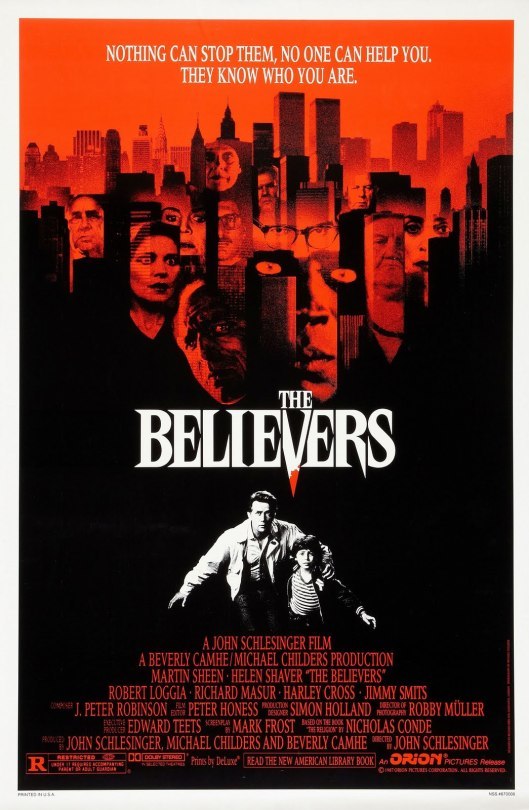
#blogtober#the believers#john schlesinger#martin sheen#helen shaver#robert loggia#jimmy smitts#malick bowens#horror#santeria#voodoo#mark frost#thriller
6 notes
·
View notes
